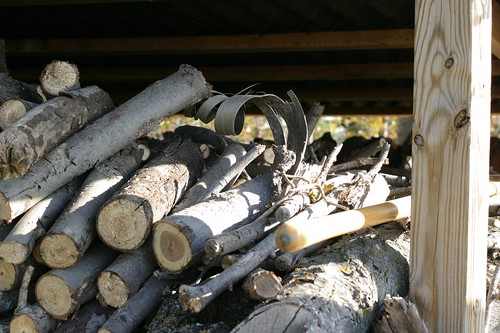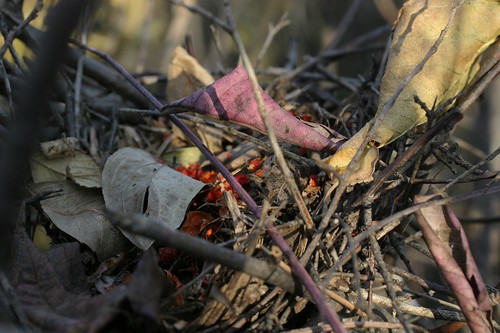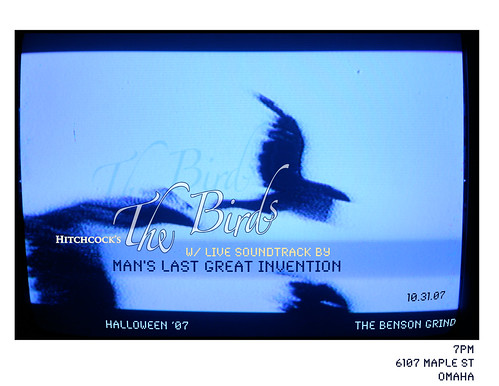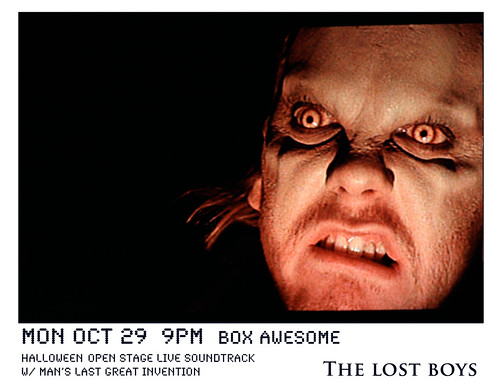films, photographs, cycling, technology, and food enjoyed (mostly) in beautiful nebraska
12.18.2007
Two Acts, Overheard
1. Pancake
2. We don't have pancakes
1. He said "pancakes"
2. No pancakes
1. I swear, "pancakes"
2. Pound cake
1. Pound cake!
2. It sounds like pancake!
1. Oh, pound cake!
2. Pancake, pound cake, pancake, pound cake
1. Pancake, pound cake, pancake, pound cake
2. Pancake, pound cake
1. Ok, I need some pound cake
Act II
Mommy, but did you know that bunnies don't speak?
12.11.2007
12.02.2007
11.30.2007
Winter, I am so ready for you

Also, you should go to the Clean Part tomorrow night. 7 PM at the Sheldon.
Cynthia Arrieu-King! Jason Bredle! Jen Tynes!
(Emphasis theirs, though I agree)

11.29.2007
11.24.2007
FB
11.18.2007
11.17.2007
11.12.2007
Writing in the Dark at 3 AM
double bed
bed post
postcard
card stock
stockyard
yardage
age-old
old hat
hat box
box car
car door
door-jamb
jamboree
11.07.2007
11.02.2007
New York Mathias Reading

Mathias Svalina, NoCoastFilm's most pimped poet, will be reading in Brooklyn tonight.
You really do owe it to yourself to be there. He likes wolves, and writes poems about them with Jules Cohen.
Kitchen Press & Cannibal Books
invite you to eat from the chopping block
w/
Erin Elizabeth Burke Run Down the Emphasis (Kitchen)
Thibault Raoult I'll Say I'm Only Visiting (Cannibal)
Mathias Svalina Why I Am White (Kitchen)
Friday, November 2nd, 8 PM
Unnameable Books
456 Bergen Street
btwn. 5th & Flatbush
Refreshments served, but you may also BYOB.
Kitchen Press and Cannibal Books products will be available for consumption.
Unnameable Books carries an excellent selection of poetry from independent presses.
This event is free for all.

10.29.2007
Mathias Svalina & Zachary Schomburg

Sheldon Memorial Art Gallery: Ana Bozicevic-Bowling, Julia Cohen & Ken Rumble
Theme: Fox Masks
Poetry Out Loud
Reading series brings in some of the nation’s best
by Avishay Artsy
Sometimes it takes free peanuts and pie to get people to listen to contemporary poetry.
When Mathias Svalina and Zachary Schomburg began directing The Clean Part Reading Series in 2005, audiences at Lincoln’s Tugboat Gallery cracked open peanuts and tossed shells on the floor. Raffle tickets were handed out for a pie, which sat in its box atop the lectern until just before the final reading. Then a lucky winner, usually a hapless undergraduate required to attend, would have his or her photo taken with the two beaming organizers.
“We don’t have pies anymore. It’s actually regressed,” Svalina said, laughing. “It used to be a lot cooler, apparently.”
Readings are now held at the University of Nebraska-Lincoln’s Sheldon Memorial Art Gallery. Featured poets are still taken out for post-reading pizza and beer. The two believe it’s a way to foster kinship between poetry enthusiasts in Lincoln and up-and-coming poets across the country.
The series quickly developed a positive reputation. Despite having no money to reimburse visiting poets, “literally, within two months, people were emailing us to see if they could travel here to read,” Svalina said.
The dozen Clean Part readings have attracted small, intimate crowds. Svalina and Schomburg acknowledge modern poetry’s limited appeal.
“It’s for 50 people. It’s not for the world. And that’s OK,” Svalina said. While poets might sell a handful of books at the readings, he said, “every single copy of that is going to be read more deeply, and better, than any copy of a Michael Crichton book is ever going to be read.”
Svalina and Schomburg are completing doctoral studies in creative writing at UNL, and teach undergraduate classes. The two publish Octopus Magazine, an online journal of poetry reviews and essays. They run the small press Octopus Books.The set of 8 chapbooks from Octopus is, I hear, in very limited supply at this point.
Schomburg, 30, began the online magazine in 2003 with a friend, notable poet Tony Tost. After moving to Lincoln in the fall of 2005, Schomburg recognized Svalina’s name from the magazine’s rejection list, “because it was an interesting name. It was a name that I would have wanted on the page, because it looked good.” He asked Svalina, 32, to become co-editor.
“We had the same ideas about poetry, what poetry could do,” Schomburg explained. The book imprint and reading series soon followed.
This has been a year of firsts for them. Schomburg’s debut collection, The Man Suit, was published in April by Black Ocean Press. The cast of talking animals and dead presidents earned Schomburg an appraisal as “one of the sincerest surrealists around” from Publishers Weekly. Svalina’s first chapbook, Why I am White, was released in August by Kitchen Press. His second publication, Creation Myths, came out this month after winning New Michigan Press’s annual chapbook competition.
Both poets create highly imaginative alternate realities, in which action defies logic; and truth, as we understand it, is turned on its head. In Creation Myths, Svalina toys with the world’s genesis, imagining a pen that drew the world into existence, or a boy cutting the world out of colored paper. Other explanations involve hovercrafts, explosions, paper clips and a mummy.
Mythology figures into Schomburg’s poems, in which Abraham Lincoln shoots himself in the head and William McKinley plays piano while falling from the sky.
“I think that history is a lot more fun than the actual one that just happened,” Schomburg said, “so why not play with that?”
When Svalina writes “In the beginning people had cornfields rather than sex parts,” and when Schomburg writes, “At a Halloween party, a lung went as a haircut, and a haircut went as a lung,” both writers show that the perceived is more important than the actual.
“[William] Blake said, ‘the imagination is real.’ Blake’s right. What we imagine is true,” Svalina said.
In The Man Suit, Schomburg writes, “Let’s bring everything that’s inside, outside.”
Poets share a sometimes-obsessive need to communicate, and by offering poetry enthusiasts a venue for cutting-edge writing, the two hope to translate what Schomburg calls the “indefinable chaos” of the world into something that can be understood.
Yes, No Coast Films is currently pimping poetry like there's nothing else that matters. And while there are plenty of other things that matter, it's a fine time to be in such close proximity to such talented and networked contemporary poets. Respek.
10.26.2007
10.25.2007
Poetry! Video Art! Politics!

I went to this reading last night. It was quite simply excellent. Hawkey had me from his first words and I could hardly believe 45 minutes had gone by when he finished.

I won't do better than Mathias Svalina's review:
Christian Hawkey. Citizen Of. Wave Books, 2007.
Review by Mathias Svalina
Within a limited set of parameters, with a limited way of defining this & at the risk of courting hyperbole I want to tell you that Christian Hawkey is a superhero. Christian Hawkey can do things in poems that normal humans can not do. Witness:
…some creatures move
a few inches every time they blink
I opened my eyes you were my wife
hand a little lower on my spine
although always the smell of tire
burning through the night some creatures
move a few inches each time they flinch
Witness:
At night the jaws of turtles creak open
to collect rain, heat lightning
reflected in their wide, sad eyes.
A tear falls. A turtle tear! Two musk deer
shiver across a meadow, dusk
a brief firefight, our names
appear & disappear, like that.
Alison I stored in a bottle in the ground.
I'm standing on a love song. I can hear it tick.
Witness:Then she removed
her Donald Duck
mask &
lay with me,
down, in the
field from which
my mind was waving
to her.If you’re not Christian Hawkey you simply cannot do that. I know. I know that you think you can, but you can’t. I’m sorry. You do not have the super powers.Even The New Yorker's Briefly Noted took note:
All three of these are dazzling displays of evocative leaping, yet they do not flail, no strings dangle from their seams. They are gemlike in their precise refraction of ecstatically wild associations. They create a world in which anything is possible, so long as it stays close to the skin & immediately accessible for an individual speaker.
But these are hardly isolated incidents of poetic heroics. Open Citizen Of to any page & randomly drop your finger down. You’ll find another one & it will clutch you & invite you to continue reading. It’s a bibliomantic divination process, but rather than auguring the future it ostends toward poetry that jumps off the page & squirms through your sheets.
Much of Hawkey’s surreal dazzle is predicated by the individual’s emotional experience. The sentimental functions as a tether to keep the surreal from clambering off to go roll around in something stinky. Yet this is a book that focuses us from the title to the role of the individual within a state. It is a book that refuses to ignore politics while at the same time remaining aesthetically unwilling to engage in a traditional kind of political debate.The title of this collection serves as a challenge to readers in a political climate where alarmism seems to alternate with complacency. “Hour with One Hand Inserted in a Time of War” asks, “Should we / stand guard at the Level of One Hand Raised / to Block the Lemon Seed of the Sun / or should we push off, down the tunnels, / dig a hole in the side of a wall & wait?” Hawkey effectively conjures a contemporary scene that seems peaceful, even while “Landmines whisper sideways underground.” Everyone, he says, is “no longer / a crow’s nest but a cluster of nests, / urban, suburban, some with turbans.” Humor, stemming more from exasperation than from delight, eases immersion into the tight-knit poems, but amid the laughter a loud alarm rings: “At least the bird’s brain was focused / on something."
He read one poem that was a dialog between video and performance artists Vito Acconci and Ana Mendieta.

Mendieta, from the Tree of Life Series (1977), wherein the artist is plastered in bark and gesso, standing next to a tree.
Poetry! Video Art! Politics!
Go buy Christian's book, or see him read somewhere.
10.23.2007
10.21.2007
10.18.2007
You Should Be Getting This

Hot off the New Michigan Press -- 2007 Chapbook Contest Winner Mathias Svalina's manuscript Creation Myths. Get it as soon as you can, read it, maybe take it to dinner or buy it a new pair of shoes.
10.16.2007
David Byrne Biking in New York
10.11.2007
Film and Other Diversions
Manufactured Landscapes

Sans Soleil

Films from the TIE Exhibition, particularly Vom Innen, Von Aussen

or not so recently:
Paprika
Into Great Silence

And lastly, a film I just might not see, unless the right person twists my arm...
The Darjeeling Limited
From the NY Times style section (emphasis mine):
Slightly offbeat in a laid-back way — the Wes Anderson of the accessory world — the youthful tie is giving the old dress code a much-needed shot in the neck.

Sorry, I think the fashion holiday just might be over for me, Wes, even though I do like the look of a man in a nice tie.
9.24.2007
Map My Ride
Oh, Google, the things you do for me.
This is a ride Felice and I really enjoyed. A quick 11 miles, all on paved bike paths, that's easy to do even if you've had a crash recently (this was originally a recovery ride for me) or a long day at work.
...
In other news, I spent several hours in the darkroom yesterday.
9.21.2007
"CHARGE!"
We get lost in the desert, lost very lost, and although we aren't
going to tell anyone that we can't possibly be any more than two miles
from civilization, the fact remains that we are lost very lost in the
desert very desert, and the car very car is having a hard very hard
very hard time getting started up again, and so we kick it very kick
it in its ass very ass and the car is still having a hard very hard
time and we are feeling lost all the more lost very lost in this
desert very desert, and there is no one around us no no one very
around us at all very all and there are birds very birds of which
there are many very many, but the birds very birds don't know don't
know how to help us and us and us help start the car very car and we
are more lost more lost and we need help need very very help need very
very help help and there is no no no one aroud us except if you count
count count those ants in the ant hill that is all we have all we have
are the ants very ants and then we wire them up yes wire them up yes I
said wire wire wire and with the force of all the ants all wired all
wired up and then on the count of three we all yell "CHARGE!"
Wow. There were several poems from her ant series, some works she'd translated from Japanese poets, a hockey love poem, and more. I was just floored by her reading and her work, like at no other reading I've ever seen. Also, I'd really like to make some animatronic ants now.
Looks like this fellow beat me to it.

That's ok. I can't build robots anyway.
9.17.2007
Apparently, Bikes Aren't Transportation
Salon reports that Bush's Transportation Secretary, Mary Peters, has made clear that she (and her bosses) believe that using federal funds to make bike paths for pedestrians and cyclists alike has zero to do with transportation infrastructure, except, of course, that it's taking dollars away from fixing roads and bridges. Welcome to the newest chapter in the gas-based culture-war:
Evildoer Cyclists Are Terrorists, Collapsing Your Bridges.
and Don't Trust Them Walkers, Neither
Now, I am fortunate to live in a city with a relatively excellent share of bike paths. From my old house, I was able to use commuter trails most of the way to work, and if I wanted to take a long bike ride mostly free from vehicular traffic, I could. While I have my gripes with the way the city has dealt with some bike-related issues -- the half-assed attempt at bike lanes downtown, and more importantly, the failure to properly communicate cycling laws (bikes are not allowed on sidewalks downtown) to drivers, and the police harassment cyclists face while scores of drunk drivers leave the bars every weekend -- for the most part, I have an easy commute and enjoy being part of a very diverse bike commuter culture.
When I pull up to my downtown building in the morning, I lock up with 15-30 (depending on the weather) state employees getting to work by bicycle. This mode of transportation meets the demands of those not willing or able to pay $60 dollars a month for parking (not to mention gas), those who enjoy the effortless scheduling of exercise as part of the work day, or those who just enjoy riding a bike or have countless other reasons not to drive. Beyond the cyclists, there are plenty of pedestrians, too -- and when it's raining, I can arrive dry at work after a 20-minute walk instead of wet after a 5-minute ride. In a city with only a shabby bus system -- buses come once an hour, and service stops before 7 PM -- and where relatively flat terrain prevails, affordable transportation comes easily on two wheels.
So, we're hogging the dollars, eh?
In fact, only about 1.5 percent of federal transportation dollars go to fund bike paths and walking trails. In the meantime, 10 percent of all U.S. trips to work, school and the store occur on bike or foot, and bicyclists and pedestrians account for about 12 percent of annual traffic fatalities, according to the Federal Highway Administration. "We represent a disproportionate share of the injuries, and we get a minuscule share of the funds," says Robert Raburn, executive director of the East Bay Bike Coalition in the San Francisco Bay Area, who calls the Peters' comments "outrageous." Plus, he notes, with problems like global warming, the obesity epidemic and energy independence, shouldn't the U.S. secretary of transportation be praising biking, not complaining about it?...
What really drives cyclists around the bend is that while they're doing their part to burn less fossil fuel -- cue slogan: "No Iraqis Died to Fuel This Bike" -- they're getting grief for being expensive from a profligate administration. "War spending, tax cuts for the rich, and gas taxes are all big sources of funding. Bike spending is not," fumes Michael Bluejay, an Austin, Texas, bike activist, in an e-mail. "The few pennies we toss toward bike projects is not enough to fix our nation's bridges, not by a freaking long shot."
I have by no means gone carless. In fact, Ande and I have two cars between the two of us, even though they're hardly ever both in use. I pay wheel taxes, and gas taxes, too, and I'd happily pay higher gas taxes for the luxury of using roads by car
when it's simply more convenient for me to do so. Granted, my definition of convenience may involve a little more internal debate than that of those used to driving everywhere, but I'm not so pious as to rule out hopping in the car at the end of a long day for an ice cream run. That, and I absolutely love road trips. I realize, however, that these come with a cost -- beyond car maintenance and the artificially low price of fuel, I'm contributing to the deterioration of the roads I drive on, the environment I'm adding emissions pollutants to, and even the animals I'm killing either by hitting them or simply by adding to the displacement of their habitats that came from the building of these roads in the first place. Since I'm not out there to build and fix the roads I might want to travel on myself, I'm perfectly willing to help pay for them to be there in the taxes I pay. In fact, when I pay taxes, part of what I expect from my government's transportation department is a range of services that help me get where I and my fellow citizens need to go, options that local entities can develop to fit the unique geographic and demographic needs of the area.
But my god, Bush Administration, don't blame my bicycling to work or to run errands or for recreation on your absolute inability to fund the domestic infrastructure on which people in this country have come to rely. People will keep buying gas even if you add taxes to it. At this point, enough of them have moved far enough away from work that they won't be able to avoid driving; the alternative transportation modes have not been developed to allow them to do so, and virgin bike commuters are unlikely to devote the energy and nerves to find a way to negotiate a 25-mile ride from one satellite suburb to another, since the only logical way to get there is probably on a freeway that specifically prohibits cyclists. Instead of picking on me and my fellow bike and foot commuters, why don't you buck up and deal with the fact that maybe you should dream up a preemptive strike on this country's transportation infrastructure, so that those poor people in the suburbs don't get crushed on a bridge on their way to work.
9.14.2007
Nolan Tredway's io

Nolan Tredway is a Lincoln painter, multimedia artist and more. The exhibit io, opening this evening at the Sheldon, promises to be a beautifully crafted interactive experience. As Nolan describes it, not interacting will provide you only an incomplete experience.
If this show is anything like his paintings, be prepared to be lost in a magical, delicate, and sometimes scary world.


More paintings from his show at Tugboat Gallery here.
His paintings remind me vividly of things I've never seen, like an archive from my imagination of worlds I never actually imagined.
9.13.2007
9.12.2007
Jake Gillespie: The Alphabet Series

Jake Gillespie has been a painter for as long as I have known him. He has also been a cartoonist and animator, though that has been more recent. I've gotten to help him on the technical end of that, which makes me feel wonderfully connected to a "real artist."
Jake's paintings are large, and what I like very much about them is that they don't pick one feel or style or technique of painting to fill the canvas. Instead, levels of high detail are found next to large strokes of soft, bright, or muted colors. They also incorporate plenty of humor, irony, and mediation, which are all things I'm fond of.
I am now also the proud owner of this Jake Gillespie painting:

The Boss and The Hulk, oil on canvas, 30 x 46", 2006.
9.08.2007
Go Coz!
9.04.2007
8.31.2007
Monsters in Awe
Monsters in Awe from nocoastfilms and Vimeo.
8.29.2007
TIE Cinema Exposition, September 16

TIE, The International Experimental Cinema Exposition - a Retrospective
The 2007 Mary Riepma Ross Media Arts Center Edition
Sunday, September 16th (Program One: 1:30PM; Program Two: 4:00PM)
With Christopher May, TIE Director & Curator, In Person
Since 2000, the internationally-based TIE festival has been a leading champion of artists still working in the medium of film, with a particular focus on both new and historical avant-garde cinema. TIE returns to UNL with two new programs specifically selected for The Ross by TIE founder/director Christopher May. The exhibition features an eclectic range of experimental films that illuminate the continuing vitality and beauty of celluloid, while subtle and at times obvious philosophical and thematic curatorial gestures conduct the flow of the programs.
TIE wishes to give special thanks to the Director of the Ross Media Arts Center, Danny Lee Ladley, for making this event possible.
Mary Riepma Ross Media Arts Center
University of Nebraska-Lincoln
313 N. 13th Street
______________________________

Pan of the Landscape
(Christopher Becks, 11 min., Canada, 16mm, 2005)
Pan of the Landscapereflects Brakhage's influence … but soon differences begin to appear … the use of painting on film as means of achieving a lyrical, visionary freedom of light and color is deeply undercut, as the solid stuff of the world begins to resemble a bit of a prison.

Vom Innen; von aussen
(Albert Sackl, 20 min., Austria, 16mm, 2006)
"Von Innen, von Aussen is a wonderfully unnerving, scrutinized, study of the human body within the context of its environment. The film opens with an empty apartment set in motion, revolving around a fixed point. This introduces the kinetic fixation that Sackl explores thoroughly within the film, the revolution. Implications of the revolution within man's own self image and man's historic worldview seem to be the larger conceptual concerns of the work. The revolution is then applied to man, himself, where Sackl plays out in a score of variations on the theme. At first, we see an unidentified nude male subject revolving clockwise on his central axis in front of a black background. It is evident that the backdrop is part of the apartment, but it clear that Sackl intends it to be an empirical environment for one portion of his study. Sackl then sets the revolving man in motion back and forth across the face of the backdrop. Sackl continues his formal investigation sending the revolving man back and forth in space.
The next major development is that the image splits and we view the man in stereo. The two men's revolutions are synchronized at first, then each takes on his own timing and direction. At this point the viewer could easily define the film as simply a visual analysis of the male figure in highly ordered motion, but then Sackl presents the environment as variable. Suddenly, the black background is lifted and anonymous natural background is presented. The landscape is initially vacant, but the spinning man soon enters stage right and makes his way back and forth, revolving all the while. The film soon cuts back to the black background where more variations are played out, the most noteworthy being the superimposition of the man's front and back. The visual bio-morphism is totally bizarre. Throughout the remainder of the film, the environment continues to shift between the apartment, natural landscapes and the black backdrop. In the end, the empiricism of the blackened space is beautifully tainted by rays of sunlight that are projected onto the scene from a window behind the camera.
Ultimately, the film has a truly meditative quality, a meditation that encompasses our notions about our bodies and the rules that govern it, both environmental and self-imposed. The precision of the filmmaking is overwhelming, in a way that is echoed in the movements of the male model. Something within the tight order applied to the man's body brings to mind the iconic work of Leonardo de Vinci, which imposes perfect geometries atop the human form."
-Noah Manos, TIE

Peng Peng
(Dietmar Brehm, 7 min., Austria, 16mm, 2006)
"Shots of eyes gazing at each other are cut with a male and female having sex, a black sky with white lightning, and an oddly canted chair while a phone buzzes and rings in the background. There is an intense, erotic tension between the two males gazing expressionlessly at one another as the mustached one chews and twists a toothpick in his mouth. It is so bizarre yet so intriguing that one can’t help but be affected by the unsettling experience.."
- Nick Army, TIE

The General Returns from One Place to Another
(Michael Robinson, 11 min., U.S., 16mm, 2006)
"Learning to love again, with fear at its side, the film draws balance between the romantic and the horrid, shaping a simultaneously skeptical and indulgent experience of the beautiful. A Frank O'Hara monologue (from a play of the same title) attempts to undercut the sincerity of the landscape, but there are stronger forces at play."

Living
(Frans Zwartjes, 15 min., Netherlands, 16mm newly restored print, 1971)
Zwartjes' masterwork and his most favorite film. "Living has an uneasy, indefinable atmosphere. This strange swaying of the camera and the music that keeps going on and on…" Living demonstrates the cinematographic mastery of Zwartjes. He is the main character of the film and handles the camera himself, pointing it towards himself with his hand held out. Zwartjes: "I was as strong as a bear in these times." The film is part of the series 'Home sweet home', in which Zwartjes explores the house in The Hague he had just moved into at the time. His wife and muse Trix plays the other role. The two characters move restlessly through the house. The film was made using an extreme wide angle lens (a 5.7), which gives the image a strong sense of estrangement.

Fourth Watch
(Janie Geiser, 9 min., U.S., 16mm, 2000)
The ancient Greeks divided the night into four sections; the last section before morning was called the fourth watch. In these hours before dawn, an endless succession of rooms is inhabited by silent film figures occupying flickering space in a mid-century house made of printed tin. Their presence is at once inevitable and uncanny. A boy turns his head in dread, a woman’s eyes look askance, a sleepwalker reaches into a cabinet which dissolves with her touch, and hands write letters behind disappearing windows. The rooms reveal themselves and fill with impossible, shadowed light. It is not clear who is watching and who is trespassing in this nocturnal drama of lost souls.

Outer Space
(Peter Tscherkassky, 10 min., Austria, 35mm, 1999)
Foreign bodies penetrate the images and cause the montage to become panic stricken. The outer edges of the film image, the empty perforations and the skeletons of the optical track rehearse an invasion; they puncture the anyway indeterminate action of the film . . . a shocker of cinematographic dysfunctions; a hell-raiser of avant-garde cinema.
______________________________

Fuses
(Carolee Schneemann, 25 min., U.S., 16mm newly-restored print, 1965)
A silent film of collaged and painted sequences of lovemaking between Schneemann and her then partner, composer James Tenney; observed by the cat, Kitch.
Fuses was recently preserved by Anthology Film Archives with support from the Andy Warhol Foundation for the Visual Arts and the Film Studies Center at the University of Chicago.
"The film was preserved from the collage original, which is as much a celluloid sculpture as it is a movie. The hand-spliced reel consists of footage shot on multiple film stocks, is painted on both sides, contains sections that are composed of splicing tape and is what you might call funky. All the prints we’ve seen of FUSES were made from later generation sources than the original. Thanks to the content of the footage and the construction of the object, Carolee was only ever able to make a reversal positive back in the late 60s. She used this master to do some stretch printing and eventually make an inter-negative, which resulted in a lot of built-in contrast, darkness, and overall softness to the image. The new print, which was made by Cineric Inc. in New York City, matches the vibrant color of the original in a way that the old prints never could. It is really something to behold."
-Andrew Lampert

Blow Job
(Andy Warhol, 35 min., U.S., 16mm newly restored print, 1963)
A sly commentary on voyeurism and audience expectations, Blow Job is a quintessential masterpiece of avant-garde filmmaking.
Silk
(Luther Price, 7 min., U.S., 16mm, 2007)
Meat Packing House
(Eduardo Darino, 17 min., Uruguay, 16mm, 1981)
While turning objectification and commodification on its head, this propagandist government film by Uruguayan filmmaker, Eduardo Darino, presents an overview of the process on meat packing in Uruguay. (Darino would eventually set up a small film studio, located in the sex district of Manhattan.)
"The film is absolutely hilarious with a real grindhouse feel (no pun intended) coming from both the music and color palette. Meat Packing House shows the incredibly clean, humane, and sexy side of cattle slaughter. And at every turn we are reminded by real life Uruguayans that they really do have "the best beef". Known for "good beef and good football", this place looks like a tourist's dream come true. People and cattle alike sunbathe on the beach and then the beautiful men and women go out to extravagant beef parties where meat platters flash in front of the camera..."
-Nick Army, TIE




















